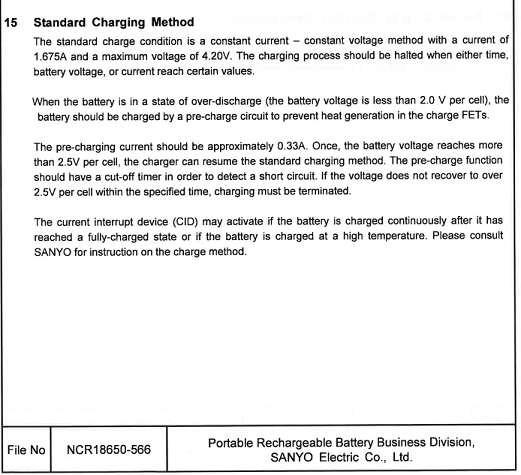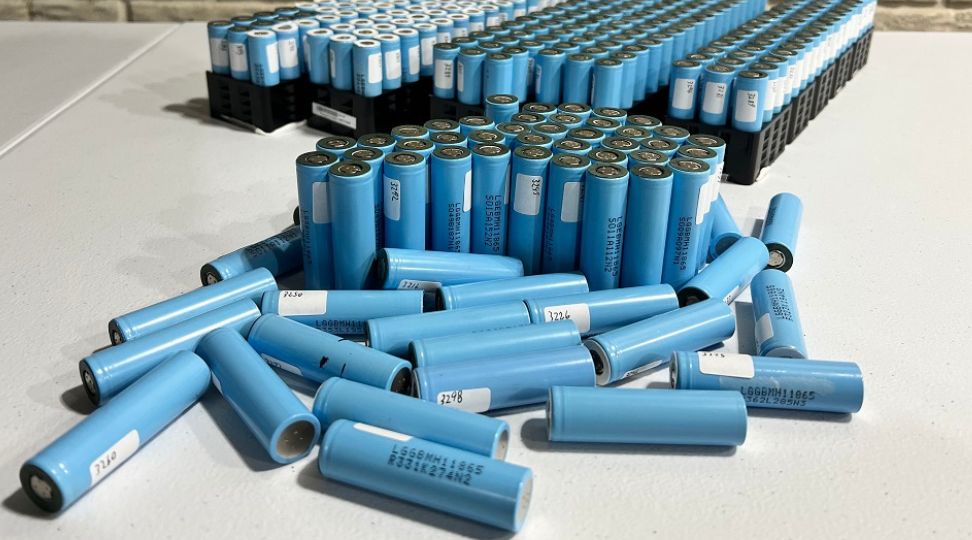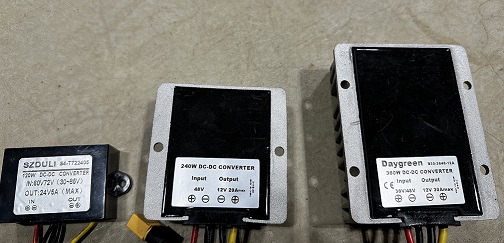
How To Recover 0v and Low Voltage Cells and Batteries
Table of Contents
So, can you recover 0v and low voltage cells and batteries? In some cases and with some cell chemistries, it is possible to recover a 0v cell.
Lead acid cells and battery packs can be recovered from 0V and used with almost the same performance as before. However, lithium-ion cells are too sensitive to over-discharge to be recovered from 0V and used in most applications, and cannot be serviced. To recover a lead acid battery, charge it for 10-12 hours and then measure the terminal voltage. If the battery is undervolted, then try to fill each compartment with water or use a desulfation device. To recover a lithium-ion battery pack from 0V, your only recourse is to check if the BMS has tripped or failed. If the BMS has tripped, place the battery on a charger or short the B- and P- connection on the BMS. If the BMS has failed, you will more than likely need to replace it.
In this article, we will explain how to recover lithium ion and lead acid batteries from a 0V state. We will also go over some of the limitations of recovering cells from 0V.
How To Recover a 0V Lithium Ion Cell
Recovering a Lithium-Ion battery cell from zero volts is not recommended, as it can result in a fire. This is because once the cell goes under about 2.5 or 2.6 volts, a chemical reaction occurs inside the cell that permanently damages it and drastically increases its internal resistance.
This means that even if you revive the cell, it will not have the same performance characteristics as it did before and will be imbalanced in terms of performance compared to the rest of the cells in the battery pack.
So, there are few reasons to revive a Lithium-Ion battery cell from zero volts, as just about every application requires a balanced battery pack for the best performance, reliability, and safety.
Any time a cell falls below a particular threshold related to its chemistry, permanent damage occurs. If that cell is revived and put in any battery pack, the battery will be impossible to balance.
For this reason, it is far better to replace a damaged Lithium-Ion battery cell with either a new one or a healthy one that more closely matches the characteristics of the other battery cells in the pack. If you decide to go this route check out our article on how to repair a broken battery pack to learn more about the process.
With that being said, if you are dead set on recovering a 0v cell, you can get a lithium-ion charger that features a cell recovery function. This mode will slowly wake up the cell and is basically the only safe way to do it. There are other ways to try to recover a 0v lithium ion cell by forcing current into it in a controlled way, but that method is far too risky and is just asking for problems. Besides, it does not produce a truly usable cell anyway.
How To Recover a Low-Voltage Lithium Ion Cell
If a lithium-ion cell has only been undervolted for a short period of time, then it will more than likely be possible to nearly fully recover it. Once a cell goes below around 2.0 volts the electrodes become plated with lithium and begin to break down.
If a cell is only in this condition for a short period of time, or if it's not too far below the cutoff point, it can be recovered. In this situation, the cell needs to be charged, but not in the normal way. Instead of charging it to 4.2 volts, you instead need to charge it to somewhere around 2.7 volts and at a very low current.

This gives the cell an opportunity to be returned to normal. If you place it on a normal charger, it could trip the charger due to the higher-than-expected voltage difference. If it does not trip the charger and the charger tries to charge the low-voltage cell at a normal charging rate, it will likely be too much current for the cell to handle given its state. For this reason, a custom charge voltage and current will need to be used. This can easily be done by buying a specific type of charger or building your own DIY battery charger.
Any time you are trying to recover a low-voltage lithium-ion cell, the process has to be monitored continuously as it is dangerous to leave a damaged cell on a charger unattended.
[[ aff type=aff ~ link=https://amzn.to/3ViQKHV ~ title=`Zanflare C4` ~ image=https://admin.cellsaviors.com/storage/3-zanflare.jpg ~ description=`This tester can help recover low voltage cells, also can be used to capacity test cells!` ~ height=small ~ buttonText=`Check Price` ]]
How To Recover a 0V Lithium Ion Battery Pack
The lithium-ion batteries that are commonly used in many electronic devices, such as laptops and light electric vehicles have a battery management system (BMS) that monitors the voltage of each cell and ensures that they are within safe operating limits. In some cases, a lithium-ion battery may show 0V on the output even though the cells are not really at 0V. This can happen when the BMS is either tripped or has failed.
In these situations, reviving a lithium-ion battery from 0V is possible because the cells are not really at 0V. The BMS is responsible for preventing overcharging and over-discharging of the cells, but if it for whatever reason fails, it can cause the battery to shut down.
This kind of situation commonly occurs when your battery voltage is low, but not low enough to trip the BMS into over-discharge protection. But then, a sudden load is put on the battery that causes the cell voltages to momentarily dip below the low voltage cutoff, tripping the BMS. If this happens, the battery may need to be put on a charger for the BMS to wake up and show a voltage on the output.
Encountering low or 0v battery packs where the BMS has just gone into sleep mode or the BMS has failed is common when you are salvaging lithium-ion cells and batteries.
In other cases, the BMS may have not tripped and the BMS could have a problem. If that ends up being the case, then the BMS may need to be replaced entirely.
If the BMS has just tripped, the battery may need to be put on a charger for around 0.1 seconds for the BMS to return to normal. In many cases, the B- and P- connection on the BMS can be shorted out to sort of ‘jump start’ a tripped BMS. If this method does not work, nothing bad will
happen, it just won’t work. If the BMS has failed, it will more than likely need to be replaced unless you can easily identify and replace a component that is more than likely surface mounted.
So, a lithium-ion battery pack that has a BMS may show 0V on the output even though the cells are not really at 0V. In these cases, a lithium-ion battery pack can be fully recovered from 0V by repairing or replacing the BMS or simply placing the battery on a charger for a moment.
How To Recover A 0V Lead Acid Battery
One of the most common reasons a lead acid battery shows 0V is sulfation. This happens because, inside a lead acid battery, there are lead plates that are coated with lead dioxide and are separated by a porous separator.
When the battery is in use, the lead dioxide reacts with sulfuric acid and produces lead sulfate and hydrogen ions. Over a period of time, the lead sulfate builds up on the lead plates and ends up forming crystals. These crystal structures reduce the surface area of the plates and limit the battery's ability to store and release energy.
A battery can end up in this sulfated condition when it is undercharged, over-discharged, or left in a state of disuse for an extended period of time. The sulfated lead acid battery is often unable to hold a charge and may need to be replaced, but there are some ways to reverse it if it's not too bad already.
Identifying Bad Cells
To identify the bad cells in a lead acid battery, follow these steps:
- Charge the battery for at least 12 hours and then allow it to rest for 10 minutes.
- Open the battery caps and fill each compartment with water to within optimum levels.
- Measure the terminal voltage of the battery. A fully-charged battery should be in the range of 11.8 to 13.0 volts.
- Measure the voltage of each cell and identify any cells with a voltage lower than 2 volts. These are considered bad cells.
Desulfation
Once the bad cells have been identified, there are several methods for reviving a sulfated lead acid battery:
- Attaching a battery trickle charger or a smart charger to the battery and allowing it to charge continuously for a week to 10 days can sometimes do the trick.
- Wiring in an electronic desulfation device that constantly desulfates the battery acid solution is also a viable solution.
- It is possible to add a chemical desulfator to the filling ports on the battery but those chemicals seem quite hard to come by.
- In some cases, you can even top off your lead acid battery with water and then put it on a charger to bring it back from the brink.
Conclusion
When it comes to recovering cells and battery packs from a 0V state, there are some important things to know and some caveats to consider. Both lead-acid cells and complete battery packs can be viably recovered from 0V and used in a safe way with almost the same performance as before. Lithium-ion cells, however, are more sensitive to over-discharge and are impossible to service. This means that while a lithium-ion battery pack with a BMS issue can be revived from 0V, it's not practical or safe to do the same thing with lithium-ion cells.
To recover a lead acid battery, charge it for around 10 to 12 hours. Then, measure the terminal of the battery. After that, check the voltage of each cell and identify any cells with a voltage lower than 2 volts. If there are undervoltage cells, open the battery caps and fill each compartment with water to optimum levels or electrically add a desulfation device. When it comes to recovering a lithium-ion battery pack from 0V, the first thing to check is if the BMS BMS has tripped or failed. If the BMS has tripped, place the battery on a charger for a moment or short the B- and P- connection on the BMS. If the BMS has failed, replace the BMS or a component that is causing the failure.
We hope this article provided everything that you were looking for in regards to recovering 0V and low voltage cells and batteries. Thanks for reading!



